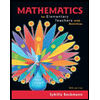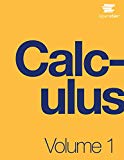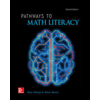Given:
The linear differential equation is y′=2lnxy such that y(1)=2 and the value of step size is h=0.1 and h=0.05.
Concept used:
Runga-Kutta method:
The solution of a linear differential equation of the form y′=f(x,y) is given as follows:
yn+1=yn+16(k1+2k2+2k3+k4), where
k1=f(xn,yn)k2=f((xn+h2),(yn+hk12))k3=f((xn+h2),(yn+hk22))k4=f((xn+h),(yn+hk3))
Euler’s method
The approximated solution for the first order linear differential equation of the form y′=f(x,y) with initial value as y(x0)=y0 with a step size of h is given as follows:
yn+1=yn+hf(xn,yn), where xn=x0+nh.
Improved Euler’s method:
As per the Improved Euler’s method the solution of a linear differential equation of the form y′=f(x,y) is given as follows:
yn+1*=yn+hf(xn,yn)yn+1=yn+h2(f(xn,yn)+f(xn+1,yn+1*))
Calculation:
The linear differential equation is given as follows:
y′=2ln(xy)
The value of step size is given as h=0.1 and h=0.05.
The initial value is given as y(1)=2.
The given differential equation is of the form y′=f(x,y).
f(x,y)=ln(xy)
This implies that x0=1 and y0=2.
Obtain the solution of the given differential equation by Euler’s method for h=0.1.
As per the Euler’s method the solution of a linear differential equation of the form y′=f(x,y) is given as follows:
yn+1=yn+hf(xn,yn) …(1)
Substitute 0 for n in equation (1).
y1=y0+hf(x0,y0)
Substitute the value of x0, y0 and h in the above equation.
y1=2+(0.1)f(1,2)=2+(0.1)⋅2⋅ln(2)=2+0.1386=2.1386
Therefore, the value of y1 or y(1.1) is 2.1386.
Similarly, use the above procedure and the value of y(1.2), y(1.3). y(1.4) and y(1.5).
| xn |
yn(Euler’s Method)
h=0.1 |
yn(Euler’s Method)
h=0.05 |
| 1.00 | 2.0000 | 2.0000 |
| 1.05 | | 2.0693 |
| 1.10 | 2.1386 | 2.1469 |
| 1.15 | | 2.2328 |
| 1.20 | 2.3097 | 2.3272 |
| 1.25 | | 2.4299 |
| 1.30 | 2.5136 | 2.5409 |
| 1.35 | | 2.6604 |
| 1.40 | 2.7504 | 2.7883 |
| 1.45 | | 2.9245 |
| 1.50 | 3.0201 | 3.0690 |
Table 1
Table 1 represents the value of y(1.2), y(1.3). y(1.4) and y(1.5) calculated by Euler’s method.
Obtain the solution of the given differential equation by Improved Euler’s method for h=0.1.
As per the Improved Euler’s method the solution of a linear differential equation of the form y′=f(x,y) is given as follows:
yn+1*=yn+hf(xn,yn) …(2)yn+1=yn+h2(f(xn,yn)+f(xn+1,yn+1*)) …(3)
Substitute 0 for n in equation (2).
y1*=y0+hf(x0,y0)
Substitute the value of x0, y0 and h in the above equation.
y1*=2+(0.1)f(1,2)=2+(0.1)⋅2⋅ln(2)=2+0.1386=2.1386
Substitute 0 for n in equation (3).
y1=y0+h2(f(x0,y0)+f(x1,y1*))
Substitute the value of x0, y0, x1, y1* and h in the above equation.
y1=2+0.12(f(1,2)+f(1.1,2.1386))=2+(0.05)(2ln(2)+2ln(1.1⋅2.1386))=2+(0.05)(1.3863+1.7109)=2.1549
Therefore, the value of y1 or y(1.1) is 2.1549.
Similarly, with above procedure used the value of y(1.2), y(1.3). y(1.4) and y(1.5).
| xn |
yn (Improved Euler’s Method)
h=0.1 |
yn (Improved Euler’s Method)
h=0.05 |
| 1.00 | 2.0000 | 2.0000 |
| 1.05 | | 2.0735 |
| 1.10 | 2.1549 | 2.1554 |
| 1.15 | | 2.2459 |
| 1.20 | 2.3439 | 2.3450 |
| 1.25 | | 2.4527 |
| 1.30 | 2.5672 | 2.5689 |
| 1.35 | | 2.6937 |
| 1.40 | 2.8246 | 2.8269 |
| 1.45 | | 2.9686 |
| 1.50 | 3.1157 | 3.1187 |
Table 2
Table 2 represents the value of y(1.2), y(1.3). y(1.4) and y(1.5) calculated by Improved Euler’s method.
Obtain the solution of the given differential equation by Euler’s modified method for h=0.1.
As per the Runga-Kutta method of fourth order the value of yn+1 is given as follows:
yn+1=yn+16(k1+2k2+2k3+k4) …(4)
Here, the value of k1, k2 ,k3 and k4 is given as follows:
k1=f(xn,yn) …(5)k2=f((xn+h2),(yn+hk12)) …(6)k3=f((xn+h2),(yn+hk22)) …(7)k4=f((xn+h),(yn+hk3)) …(8)
Substitute 0 for n in equation (4).
y1=y0+h6(k1+2k2+2k3+k4) …(9)
Calculate the value of k1 as follows:
k1=f(x0,y0)=f(1,2)=2ln(2)=1.3863
Calculate the value of k2 as follows:
k2=f((x0+h2),(y0+hk12))=f((1+0.05),(2+((0.05)⋅(1.3863))))=f(1.05,2.069315)
Further solve the above equation.
k2=2ln(1.05⋅2.069315)=1.5520
Calculate the value of k1 as follows:
k3=f((x+h2),(y0+hk22))=f((1.05),(2.0776))=2ln(1.05⋅2.0776)=1.5600
Calculate the value of k4 as follows:
k4=f((x0+h),(y0+hk3))=f((1.1),(2.1560))=2ln(1.1⋅2.1560)=1.7271
Substitute the value of k1, k2, k3, k4 and y0 in equation (9).
y1=y0+0.16(k1+2k2+2k3+k4)=2+0.16(1.3863+2⋅1.5520+2⋅1.5600+1.7271)=2+0.1556=2.1556
Therefore, the value of y1 or y(1.1) is 2.1556.
Similarly, with above procedure used the value of y(1.2), y(1.3). y(1.4) and y(1.5).
| xn |
yn (Runga-Kutta 4th order)
h=0.1 |
yn (Runga-Kutta 4th order)
h=0.05 |
| 1.00 | 2.0000 | 2.0000 |
| 1.05 | | 2.0736 |
| 1.10 | 2.1556 | 2.1556 |
| 1.15 | | 2.2462 |
| 1.20 | 2.3454 | 2.3454 |
| 1.25 | | 2.4532 |
| 1.30 | 2.5695 | 2.5695 |
| 1.35 | | 2.6944 |
| 1.40 | 2.8278 | 2.8278 |
| 1.45 | | 2.9696 |
| 1.50 | 3.1197 | 3.1197 |
Table 3
Table 3 represents the value of y(1.2), y(1.3). y(1.4) and y(1.5) calculated by Runga-Kutta method.
The table which shows a comparison between the values of y(1.2), y(1.3), y(1.4) and y(1.5) obtained by Euler’s method, improved Euler’s method and Runga-Kutta method of fourth order is as below.
| xn |
yn (Euler’s Method)
h=0.1 |
yn (Euler’s Method)
h=0.05 |
yn (Improved Euler’s Method)
h=0.1 |
yn (Improved Euler’s Method)
h=0.05 |
yn (Runga-Kutta 4th order)
h=0.1 |
yn (Runga-Kutta 4th order)
h=0.05 |
| 1.00 | 2.0000 | 2.0000 | 2.0000 | 2.0000 | 2.0000 | 2.0000 |
| 1.05 | | 2.0693 | | 2.0735 | | 2.0736 |
| 1.10 | 2.1386 | 2.1569 | 2.1549 | 2.1554 | 2.1556 | 2.1556 |
| 1.15 | | 2.2328 | | 2.2459 | | 2.2462 |
| 1.20 | 2.3097 | 2.3272 | 2.3439 | 2.3450 | 2.3454 | 2.3454 |
| 1.25 | | 2.4299 | | 2.4527 | | 2.4532 |
| 1.30 | 2.5136 | 2.5409 | 2.5672 | 2.5689 | 2.5695 | 2.5695 |
| 1.35 | | 2.6604 | | 2.6937 | | 2.6944 |
| 1.40 | 2.7504 | 2.7883 | 2.8246 | 2.8269 | 2.8278 | 2.8278 |
| 1.45 | | 2.9245 | | 2.9686 | | 2.9696 |
| 1.50 | 3.0201 | 3.0690 | 3.1157 | 3.1187 | 3.1197 | 3.1197 |
Table 4
Thus, table 4 shows the comparison of the values of y(1.2), y(1.3), y(1.4) and y(1.5) obtained by Euler’s method, improved Euler’s method and Runga-Kutta method of fourth order.

 Discrete Mathematics and Its Applications ( 8th I...MathISBN:9781259676512Author:Kenneth H RosenPublisher:McGraw-Hill Education
Discrete Mathematics and Its Applications ( 8th I...MathISBN:9781259676512Author:Kenneth H RosenPublisher:McGraw-Hill Education Mathematics for Elementary Teachers with Activiti...MathISBN:9780134392790Author:Beckmann, SybillaPublisher:PEARSON
Mathematics for Elementary Teachers with Activiti...MathISBN:9780134392790Author:Beckmann, SybillaPublisher:PEARSON
 Thinking Mathematically (7th Edition)MathISBN:9780134683713Author:Robert F. BlitzerPublisher:PEARSON
Thinking Mathematically (7th Edition)MathISBN:9780134683713Author:Robert F. BlitzerPublisher:PEARSON Discrete Mathematics With ApplicationsMathISBN:9781337694193Author:EPP, Susanna S.Publisher:Cengage Learning,
Discrete Mathematics With ApplicationsMathISBN:9781337694193Author:EPP, Susanna S.Publisher:Cengage Learning, Pathways To Math Literacy (looseleaf)MathISBN:9781259985607Author:David Sobecki Professor, Brian A. MercerPublisher:McGraw-Hill Education
Pathways To Math Literacy (looseleaf)MathISBN:9781259985607Author:David Sobecki Professor, Brian A. MercerPublisher:McGraw-Hill Education




